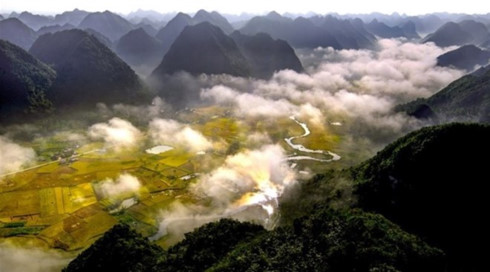
An outdoor photo exhibition showcasing the beauty of the landscape, culture and people of ASEAN countries opened at Ly Thai To Statue Square on Hanoi’s walking street on August 5.
The exhibition,
titled "ASEAN Countries and People”, is organised by the Ministry of
Culture, Sports and Tourism on the occasion of the 50th founding
anniversary of ASEAN (1967-2017).
The event displays 230 works by 136 photographers from 10 ASEAN countries, 61
of whom are Vietnamese. Fifty photos were taken in Vietnam, while 180 others
were captured in the other nine ASEAN countries (20 photos each), all of which
vividly and truthfully depict the country, people, culture, society, economy
and exchange activities of the member nations.
The photos were selected from a contest launched by the Department of Art,
Photography and Exhibitions under the Ministry of Culture, Sports and Tourism,
which attracted 10,127 entries by 1,248 amateur and professional artists from
across the ASEAN region
"This is the
photographic exhibition with the highest number of entries that has been held
by the Ministry of Culture, Sports and Tourism of Vietnam in recent
years. The photographic event will enhance mutual understanding and
relations among the countries, contributing to building a unified, active,
developed, peaceful and prosperous ASEAN community,” said Vi Kien
Thanh, head of the ministry’s Department of Fine Arts, Photography and
Exhibition.
The organising board also revealed that the exhibition has attracted the
attention of many photographers within the region. Since the submitting and
marking of the entries was conducted via the internet, many countries sent a
large number of entries by a number of participants.
The 10 most outstanding works by 10 photographers, who are also representatives
of 10 ASEAN countries, were awarded trophies titled "ASEAN photos -
2017” by the organising board.
The awarded photos present new angles of the beauty of the local culture and
people, such as We Love Malaysia by Tan Ee Long from
Malaysia, Kyite Htee Yoe-The Golden Rock Pagoda by Nyaung U Than Htay
from Myanmar and Bac Son Valley by Vu Kim Khoa from Vietnam.
The exhibition will last until August 11.
Source: VOV
With an increasingly vibrant and widespread emulation movement aimed at building cultured residential areas and cultured families, Yen Thuy District has been making steady progress toward improving both the material and spiritual well-being of its people, while fostering a civilized, prosperous, beautiful, and progressive community.
Once lacking recreational spaces and community facilities, Residential Group 2 in Quynh Lam Ward (Hoa Binh City) has recently received attention for the construction of a new, spacious, and fully equipped cultural house. The project followed the model of state support combined with public contributions in both labor and funding.
The "All people unite to build cultural life" movement, which has been effectively integrated with Kim Boi district’s socio-economic development goals, is fostering a lively spirit of emulation across local residential areas, hamlets, villages, public agencies, and enterprises. In addition, through the initiative, traditional cultural values are being preserved and promoted, while community solidarity and mutual support in poverty reduction and economic development are being strengthened.
A working delegation of the Hoa Binh provincial People’s Committee led by its Permanent Vice Chairman Nguyen Van Toan on June 11 inspected the progress of a project to build the Mo Muong Cultural Heritage Conservation Space linked to tourism services in Hop Phong commune, Cao Phong district.
Born and growing in the heroic land of Muong Dong, Dinh Thi Kieu Dung, a resident in Bo town of Kim Boi district, in her childhood was nurtured by the sweet lullabies of her grandmother and mother. These melodies deeply imprinted on her soul, becoming an inseparable part of her love for her ethnic group's culture. For over 20 years, this love for her hometown has driven Dung to research, collect, and pass down the cultural values of the Muong people to future generations.
In the final days of May, the Ethnic Art Troupe of Hoa Binh Province organized performances to serve the people in remote, mountainous, and particularly disadvantaged areas within the province. These were not just ordinary artistic shows, but they were the meaningful journeys aimed at spreading cultural values, enhancing the spiritual life of the people and contributing to the preservation of ethnic minority cultural identities.



